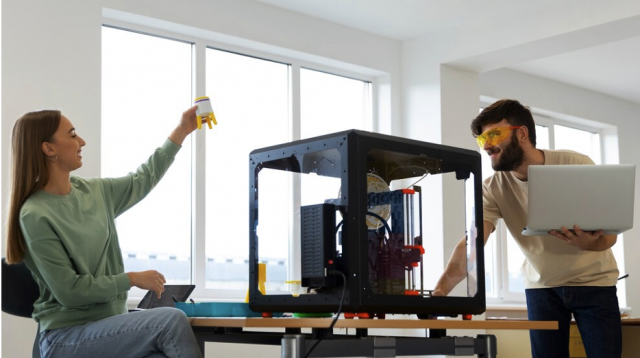In recent years, steel 3D printing has emerged as a game-changing technology in the manufacturing industry, offering unprecedented capabilities for producing complex metal parts and components with precision and efficiency. Steel 3D printers, also known as metal additive manufacturing systems, utilize advanced techniques such as laser powder bed fusion (LPBF) and binder jetting to create high-strength steel parts directly from digital designs. In this comprehensive guide, we’ll explore the principles of steel 3D printing, the evolution of steel 3D printers, and their diverse applications across various industries.
Understanding Steel 3D Printing: Process and Principles
Steel 3D printing, like other metal additive manufacturing processes, involves building up metal parts layer by layer based on a digital model or design file. The process typically consists of the following steps:
- Digital Design: The process begins with the creation of a digital model or design file using computer-aided design (CAD) software. The digital model defines the geometry, dimensions, and specifications of the desired steel part.
- Preparation of Build Platform: The build platform is prepared by applying a thin layer of steel powder or substrate material. The powder bed serves as the foundation for building up the steel part layer by layer.
- Selective Fusion: In laser powder bed fusion (LPBF), a high-energy laser beam is directed onto the steel powder, selectively melting or sintering it to form the first layer of the part. The laser follows the path defined by the digital model, selectively fusing the steel powder to create the desired shape. In binder jetting, a binding agent is selectively deposited onto a layer of steel powder to create the desired shape, which is then sintered to fuse the particles together.
- Layer-by-Layer Building: Once the first layer is formed, the build platform is lowered, and a new layer of steel powder is spread on top. The energy source or binding agent then fuses or binds the next layer of powder onto the previous layer, repeating the process until the entire part is built up layer by layer.
- Post-Processing: After printing is complete, the steel part may undergo post-processing steps such as heat treatment, surface finishing, and machining to achieve the desired mechanical properties, surface finish, and dimensional accuracy.
By following these principles, manufacturers can produce steel parts with complex geometries, fine details, and excellent mechanical properties using 3D printing technology.
Evolution of Steel 3D Printers
Steel 3D printing technology has undergone significant evolution and innovation since its inception. Some key milestones in the evolution of steel 3D printers include:
- Development of Laser Powder Bed Fusion (LPBF): LPBF was one of the first techniques developed for 3D printing steel parts. It utilizes a high-energy laser beam to selectively melt or sinter steel powder, layer by layer, to create metal parts with high precision and resolution.
- Advancements in Materials: Over the years, there have been significant advancements in steel powders tailored for 3D printing applications. New alloys and compositions have been developed to enhance the mechanical properties, corrosion resistance, and heat resistance of 3D-printed steel parts, expanding the range of applications and industries that can benefit from steel 3D printing.
- Improvements in Process Control: Advances in process control and monitoring systems have improved the reliability, repeatability, and quality of steel 3D printing. Real-time monitoring of printing parameters such as temperature, laser power, and powder bed density helps ensure consistent and reliable results.
- Introduction of Binder Jetting Technology: Binder jetting technology has emerged as an alternative approach to 3D printing steel parts. In binder jetting, a binding agent is selectively deposited onto a layer of steel powder to create the desired shape, offering advantages such as faster printing speeds and lower material costs compared to traditional LPBF.
- Integration of Automation and Robotics: The integration of automation and robotics into steel 3D printing systems has increased productivity, efficiency, and scalability. Automated powder handling, part removal, and post-processing operations streamline workflows and reduce manual labor, enabling manufacturers to maximize throughput and reduce production costs.
- Advancements in Post-Processing Techniques: Post-processing techniques such as heat treatment, surface finishing, and machining have been optimized to improve the mechanical properties, surface finish, and dimensional accuracy of 3D-printed steel parts. These advancements enable manufacturers to achieve the desired performance and aesthetics for their applications.
Applications of Steel 3D Printing
Steel 3D printing has revolutionized various industries, offering innovative solutions and applications across diverse sectors. Some key applications of steel 3D printing include:
- Aerospace and Defense: In the aerospace and defense industries, steel 3D printing is used to produce lightweight, high-strength components for aircraft, spacecraft, and military equipment. Components such as engine parts, structural brackets, and heat exchangers are manufactured using 3D printing technology to improve performance, reduce weight, and enhance durability.
- Automotive: In the automotive industry, steel 3D printing is used for prototyping, tooling, and production of custom parts and components. Automotive manufacturers leverage the design freedom and flexibility of 3D printing to create complex geometries, lightweight structures, and optimized components for vehicles, including engine parts, suspension components, and chassis reinforcements.
- Medical: In the medical industry, steel 3D printing is used to produce surgical instruments, implants, and prosthetics with superior biocompatibility and precision. Custom implants for orthopedic and craniofacial surgeries, surgical instruments such as forceps and clamps, and dental prosthetics are manufactured using 3D printing technology to improve patient outcomes and reduce surgery time and costs.
- Oil and Gas: In the oil and gas industry, steel 3D printing is used to produce components for drilling equipment, valves, and pumps. 3D-printed steel parts offer corrosion resistance, high temperature resistance, and excellent mechanical properties, making them ideal for harsh operating environments in the oil and gas sector.
- Tooling and Manufacturing: In general manufacturing applications, steel 3D printing is used for producing custom tooling, molds, and fixtures for injection molding, casting, and machining processes. Manufacturers leverage the speed and flexibility of 3D printing to create complex tooling and prototypes with rapid turnaround times, reducing time-to-market and production costs.
Future Trends and Developments in Steel 3D Printing
The field of steel 3D printing is continually evolving, with ongoing advancements and innovations driving the industry forward. Some key trends and developments to watch for in the future include:
- Multi-Material Printing: Advances in multi-material printing technology are enabling the fabrication of steel parts with integrated functionalities, such as embedded sensors, electronics, and coatings. Multi-material printing opens up new possibilities for creating complex, customized parts with enhanced performance and functionality.
- Large-Scale Printing: Ongoing developments in large-scale steel 3D printing technology are expanding the range of applications and industries that can benefit from additive manufacturing. Large-scale printers capable of printing oversized parts and structures are revolutionizing industries such as construction, infrastructure, and marine engineering.
- In-Situ Manufacturing: The concept of in-situ manufacturing, or printing parts directly at the point of use, is gaining traction in industries such as aerospace, defense, and energy. In-situ manufacturing reduces lead times, transportation costs, and material waste by producing parts on-demand, where and when they are needed.
- Hybrid Manufacturing: The integration of additive manufacturing with traditional subtractive processes such as milling, turning, and drilling is known as hybrid manufacturing. Hybrid manufacturing combines the design flexibility of 3D printing with the precision and surface finish of machining, offering new opportunities for optimizing production workflows and achieving complex geometries.
- Digital Supply Chain Integration: Digital supply chain integration involves leveraging digital design files, simulation tools, and data analytics to optimize the entire manufacturing process, from design and prototyping to production and distribution. By integrating steel 3D printing into the digital supply chain, manufacturers can achieve greater agility, efficiency, and responsiveness to customer needs.
Conclusion
Steel 3D printing has emerged as a transformative technology with far-reaching implications for manufacturing across industries. By enabling the production of lightweight, durable, and customized parts with unparalleled design freedom, steel 3D printing is driving innovation, efficiency, and sustainability in manufacturing processes. As the field continues to evolve and advance, the potential applications and opportunities for steel 3D printing are virtually limitless. By embracing this cutting-edge technology and harnessing its full potential, manufacturers can unlock new possibilities for creativity, customization, and collaboration, shaping the future of manufacturing in the digital age.







